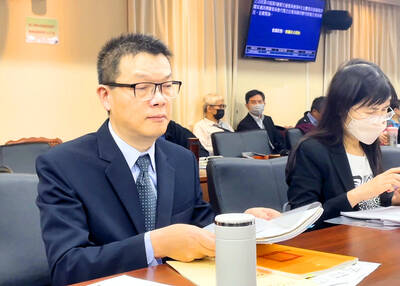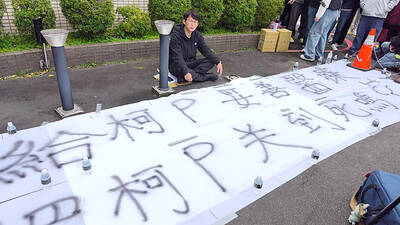Although earthquake notification apps have become a big hit among smartphone users after a magnitude 6.4 earthquake struck southern Taiwan on Feb. 6, killing 116 people and injuring hundreds more, such apps might be of limited benefit because alerts take at least 12 seconds to reach users.
Four apps — only available in Chinese — have been developed and released for free download by private developers in cooperation with the Central Weather Bureau (CWB). Users can receive real-time notifications of the location and magnitude of an earthquake and the earthquake’s intensity in different areas.
As earthquakes cannot be predicted, the bureau can only analyze a seismic wave immediately after an earthquake strikes before transmitting the data, Seismological Center division chief Chiang Chia-hao (江家豪) said on Monday.
It takes the center 12 seconds to process a seismic wave and another 0.15 seconds to transmit the data to app users, Chiang said.
Given that a seismic wave runs 5km per second, only app users living more than 60km from the epicenter of an earthquake would have adequate time to prepare for a tremor, depending on network connectivity and whether the app is running.
Taking the Feb. 6 earthquake as an example, Chiang said that as the quake’s epicenter was in Kaohsiung’s Meinong District (美濃), people in Chiayi County had five seconds to react, while Taipei residents had 20 seconds.
Although the intensity of an earthquake weakens further from the epicenter, having advanced knowledge of a tremor would help people to prepare for it, Chiang said.
“Some people would have time to move away from bookshelves or avoid falling objects,” he said.
The Earthquake Disaster Prevention and Relief and EEW Earthquake Report apps are available on both Android and Apple devices, while the Taiwan Earthquake Early Warning System and KNY Taiwan Weather Earthquake Report apps are only available on Android devices.
For people who are unable to read Chinese, the bureau recommends its Taiwan Weather App for Android devices and its real-time earthquake reports on the bureau’s official Web site.
Taiwan’s three largest telecommunication service providers — Chunghwa Telcom, Taiwan Mobile and Far EasTone Telecommunications — are to continue releasing simulated disaster alerts in designated areas to their subscribers later this month.
The measures, if implemented on April 1 as scheduled, are to be part of the government’s disaster warning system aimed at providing the public with disaster updates as quickly as possible, the National Communications Commission said.
Any 3G or 4G mobile devices capable of receiving broadcast messages are to release warning sounds or vibrate whenever a disaster alert is received. A series of simulated disaster alerts began in Pingtung County last month, the commission said.

The High Prosecutors’ Office yesterday withdrew an appeal against the acquittal of a former bank manager 22 years after his death, marking Taiwan’s first instance of prosecutors rendering posthumous justice to a wrongfully convicted defendant. Chu Ching-en (諸慶恩) — formerly a manager at the Taipei branch of BNP Paribas — was in 1999 accused by Weng Mao-chung (翁茂鍾), then-president of Chia Her Industrial Co, of forging a request for a fixed deposit of US$10 million by I-Hwa Industrial Co, a subsidiary of Chia Her, which was used as collateral. Chu was ruled not guilty in the first trial, but was found guilty

DEADLOCK: As the commission is unable to forum a quorum to review license renewal applications, the channel operators are not at fault and can air past their license date The National Communications Commission (NCC) yesterday said that the Public Television Service (PTS) and 36 other television and radio broadcasters could continue airing, despite the commission’s inability to meet a quorum to review their license renewal applications. The licenses of PTS and the other channels are set to expire between this month and June. The National Communications Commission Organization Act (國家通訊傳播委員會組織法) stipulates that the commission must meet the mandated quorum of four to hold a valid meeting. The seven-member commission currently has only three commissioners. “We have informed the channel operators of the progress we have made in reviewing their license renewal applications, and

‘DENIAL DEFENSE’: The US would increase its military presence with uncrewed ships, and submarines, while boosting defense in the Indo-Pacific, a Pete Hegseth memo said The US is reorienting its military strategy to focus primarily on deterring a potential Chinese invasion of Taiwan, a memo signed by US Secretary of Defense Pete Hegseth showed. The memo also called on Taiwan to increase its defense spending. The document, known as the “Interim National Defense Strategic Guidance,” was distributed this month and detailed the national defense plans of US President Donald Trump’s administration, an article in the Washington Post said on Saturday. It outlines how the US can prepare for a potential war with China and defend itself from threats in the “near abroad,” including Greenland and the Panama

Taiwan People’s Party (TPP) Chairman Huang Kuo-chang (黃國昌) yesterday appealed to the authorities to release former Taipei mayor Ko Wen-je (柯文哲) from pretrial detention amid conflicting reports about his health. The TPP at a news conference on Thursday said that Ko should be released to a hospital for treatment, adding that he has blood in his urine and had spells of pain and nausea followed by vomiting over the past three months. Hsieh Yen-yau (謝炎堯), a retired professor of internal medicine and Ko’s former teacher, said that Ko’s symptoms aligned with gallstones, kidney inflammation and potentially dangerous heart conditions. Ko, charged with